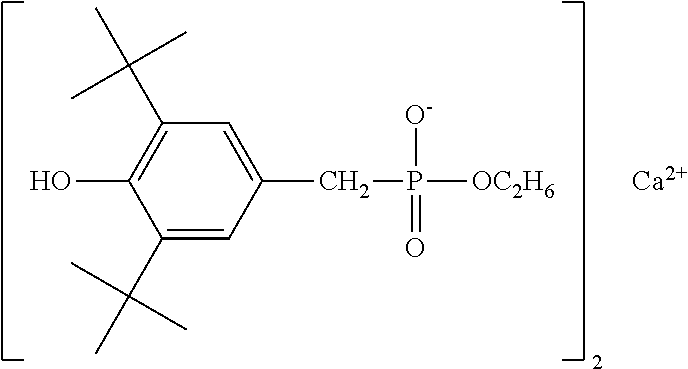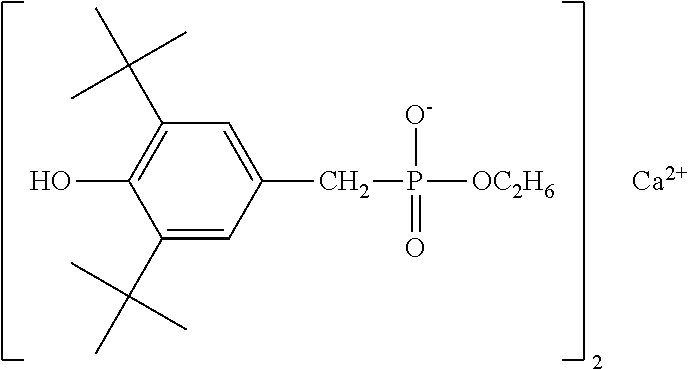Low melting point conjugate fiber
- Summary
- Abstract
- Description
- Claims
- Application Information
AI Technical Summary
Benefits of technology
Problems solved by technology
Method used
Image
Examples
examples 1 to 3
Copolymer Polyester Resin for Low-Melting Binder
[0055]Terephthalic acid and ethylene glycol were added to an ester reactor and reacted at a temperature of 258° C. by a conventional method to prepare an oligomer having a reaction rate of 96%. 2-methyl-1,3-propanediol was added per content to the obtained oligomer based on the mole of polyethylene terephthalic acid in the presence of a conventional transesterification catalyst, and the transesterification reaction was carried out at 250° C. A conventional polycondensation catalyst was added to the esterification oligomer thus obtained, and then the polycondensation reaction was carried out by raising the temperature up to 280° C. while gradually reducing the pressure so that the final decompression rate became 0.1 mmHg. The performance of the thus-prepared polyester resin was evaluated as described above, and the results are shown in Table 1 below.
examples 4 to 6
Polyester-Binder Conjugate Fiber
[0056]Terephthalic acid and ethylene glycol were added to an ester reactor and reacted at a temperature of 258° C. by a conventional method to prepare an oligomer having a reaction rate of 96%. To the oligomer thus obtained, two components in different content ratio of isophthalic acid and 2-methyl-1,3-propanediol are added, so that a mol % of adding two components could reach 30 mol % based on the polyethylene terephthalic acid. In addition, 15 mol % of diethylene glycol was added as a diol component. A conventional transesterification catalyst was also added to carry out a conventional transesterification reaction at 250° C. A conventional polycondensation catalyst was added to the esterification oligomer thus obtained, and then the polycondensation reaction was carried out by raising the temperature up to 280° C. while gradually reducing the pressure so that the final decompression rate became 0.1 mmHg.
[0057]A sheath-core type polyester binder fibe...
examples 7 to 10
lyester Resin
[0060]The amount use of each component was determined in the composition shown in Table 2 below. Terephthalic acid and ethylene glycol were added to an ester reactor and reacted at a temperature of 258° C. by a conventional method to prepare an oligomer having a reaction rate of 96%. 2-methyl-1,3-propanediol was added per content to the obtained oligomer based on the mole of polyethylene terephthalic acid. In the presence of 1000 ppm and a conventional transesterification catalyst, the transesterification reaction was carried out for trimethylol propane (hereinafter, “TMP”) as a polyfunctional component at 250° C. A conventional polycondensation catalyst was added to the esterification oligomer thus obtained, and then the polycondensation reaction was carried out by raising the temperature up to 280° C. while gradually reducing the pressure so that the final decompression rate became 0.1 mmHg. The performance of the thus-prepared polyester resin was evaluated as describ...
PUM
| Property | Measurement | Unit |
|---|---|---|
| Fraction | aaaaa | aaaaa |
| Fraction | aaaaa | aaaaa |
| Fraction | aaaaa | aaaaa |
Abstract
Description
Claims
Application Information
 Login to View More
Login to View More - R&D
- Intellectual Property
- Life Sciences
- Materials
- Tech Scout
- Unparalleled Data Quality
- Higher Quality Content
- 60% Fewer Hallucinations
Browse by: Latest US Patents, China's latest patents, Technical Efficacy Thesaurus, Application Domain, Technology Topic, Popular Technical Reports.
© 2025 PatSnap. All rights reserved.Legal|Privacy policy|Modern Slavery Act Transparency Statement|Sitemap|About US| Contact US: help@patsnap.com



